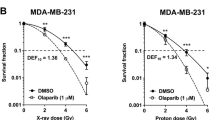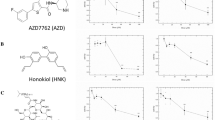Summary
Current therapies for treatment of advanced cervical cancer involve the use of cisplatin, often in combination with radiotherapy. These treatments do not lead to a high survival rate and furthermore, serious side effects are dose-limiting factors. Methyl jasmonate (MJ) was recently identified as potent and selective cytotoxic agent towards cervical cancer cells. In the present study we evaluated the effectiveness of combined treatments of MJ with cisplatin or X-irradiation on a variety of cervical cancer cells including SiHa, CaSki, HeLa and C33A. Cytotoxicity of alpha particles, emitted from 224Ra atoms, was also evaluated as a single agent and in combination with MJ. Cooperation between MJ and cisplatin in reducing cell viability (XTT assays) and survival (clonogenicity assays) was exhibited towards several cancer cell lines at a range of combination doses. MJ effectively cooperated also with X-ray irradiation, significantly lowering the radiation doses required to inhibit cell survival (ID50) of all tested cells lines. We show for the first time, that alpha irradiation selectively reduced cell viability and survival of cervical cancer cells. Lower doses of α irradiation were required as compared to X-irradiation to inhibit cell survival. Cooperation with MJ was demonstrated in part of the cancer cell lines. In conclusion, our studies point to α irradiation and MJ, novel anticancer agents, as potent candidates for treatment of cervical cancer, in single agent regiments and in combination. MJ can be added also to conventional X-ray and cisplatin therapies to increase their cytotoxic effect while lowering the effective dose.




Similar content being viewed by others
References
Parkin DM (2001) Global cancer statistics in the year 2000. Lancet Oncol 2(9):533–543
Jemal A, Bray F, Center MM, Ferlay J, Ward E, Forman D (2011) Global cancer statistics. CA Cancer J Clin 61(2):69–90
Steben M, Duarte-Franco E (2007) Human papillomavirus infection: epidemiology and pathophysiology. Gynecol Oncol 107(Suppl 1):S2–S5
DiMaio D, Liao JB (2006) Human papillomaviruses and cervical cancer. Adv Virus Res 66:125–159
Schiller JT, Castellsague X, Villa LL, Hildesheim A (2008) An update of prophylactic human papillomavirus L1 virus-like particle vaccine clinical trial results. Vaccine 26(Suppl 10):K53–K61
Lin K, Doolan K, Hung CF, Wu TC (2010) Perspectives for preventive and therapeutic HPV vaccines. J Formos Med Assoc 109(1):4–24
Movva S, Rodriguez L, Arias-Pulido H, Verschraegen C (2009) Novel chemotherapy approaches for cervical cancer. Cancer 115(14):3166–3180
Serkies K, Jassem J (2005) Chemotherapy in the primary treatment of cervical Carcinoma. Crit Rev Oncol Hematol 54(3):197–208
Maduro JH, Pras E, Willemse PH, de Vries EGE (2003) Acute and long-term toxicity following radiotherapy alone or in combination with chemotherapy for locally advanced cervical cancer. Cancer Treat Rev 29(6):471–488
Siddik ZH (2003) Cisplatin: mode of cytotoxic action and molecular basis of resistance. Oncogene 22(47):7265–7279
Savarese A, Cognetti F (2003) New Drugs in the treatment of recurrent or metastatic cervical cancer. Crit Rev Oncol Hematol 48(3):323–327
Hougardy BM, Maduro JH, Vander Zee AGJ, Willemse PHB, deJong S, de Vries EGE (2005) Clinical potential of inhibitors of survival pathways and activators of apoptotic pathways in treatment of cervical cancer: changing the apoptotic balance. Lancet Oncol 6(8):589–598
Flescher E (2007) Jasmonates in cancer therapy. Cancer Lett 245(1–2):1–10
Cohen S, Flescher E (2009) Methyl jasmonate: a plant stress hormone as an anti-cancer drug. Phytochemistry 70(13–14):1600–1609
Rotem R, Heyfets A, Fingrut O, Blickstein D, Shaklai M, Flescher E (2005) Jasmonates: novel anticancer agents acting directly and selectively on human cancer cell mitochondria. Cancer Res 65(5):1984–1993
Kniazhanski T, Jackman A, Heyfets A, Gonen P, Flescher E, Sherman L (2008) Methyl jasmonate induces cell death with mixed characteristics of apoptosis and necrosis in cervical cancer cells. Cancer Lett 271(1):34–46
Milrot E, Jackman A, Kniazhanski T, Gonen P, Flescher E, Sherman L (2012) Methyl jasmonate reduces the survival of cervical cancer cells and downregulates HPV E6 and E7, and survivin. Cancer Lett 319(1):31–38
Takimoto C, Calvo E (2005) Principles of oncologic pharmacotherapy. In: Pazdur R, Coia LR, Hoskins WJ, Wagman LD (eds) Cancer management: a multidisciplinary approach. CMP Healthcare Media, Manhasset, pp 23–42
Heyfets A, Flescher E (2007) Cooperative cytotoxicity of methyl jasmonate with anti-cancer drugs and 2-deoxy-D-glucose. Cancer Lett 250(2):300–310
Yeruva L, Hall C, Abiodun J, Elegbede JA, Carper SW (2010) Perillyl alcohol and methyl jasmonate sensitize cancer cells to cisplatin. Anticancer Drugs 21(1):1–9
Ezekwudo D, Shashidharamurthy R, Devineni D, Bozeman E, Palaniappan R, Selvaraj P (2008) Inhibition of expression of anti-apoptotic protein Bcl-2 and induction of cell death in radioresistant human prostate adenocarcinoma cell line (PC-3) by methyl jasmonate. Cancer Lett 270(2):277–285
Arazi L, Cooks T, Schmidt M, Keisari Y, Kelson I (2007) Treatment of solid tumors by interstitial release of recoiling short-lived alpha emitters. Phys Med Biol 52(16):5025–5042
Cooks T, Arazi L, Schmidt M, MarshakG KI, Keisari Y (2008) Growth retardation and destruction of experimental squamous cell carcinoma by interstitial radioactive wires releasing diffusing alpha-emitting atoms. Int J Cancer 122(7):1657–1664
Cooks T, Schmidt M, Bittan H, Lazarov E, Arazi L, Kelson I, Keisari Y (2009) Local control of lung derived tumors by diffusing alpha-emitting atoms released from intratumoral wires loaded with radium-224. Int J Radiat Oncol Biol Phys 74(3):966–973
Horev-Drori G, Cooks T, Bittan H, Lazarov E, Scmidt M, Arazi L, Efrati M, Kelson I, Keisari Y (2012) Local control of malignant pancreatic tumors by a combined treatment with intratumoral 225Radium-loaded wires releasing alpha-emitting atoms and chemotherapy. Transl Res 159(1):32–41
Lazarov E, Arazi L, Efrati M, Crooks T, Scmidt M, Keisari Y, Kelson I (2012) Comparative in vitro microdosimetric study of murine-and human-derived cancer cells exposed to alpha particles. Radiat Res 177(3):280–287
Alfandari J, Shnitman Magal S, Jackman A, Schlegel R, Gonen P, Sherman L (1999) HPV16 E6 oncoprotein inhibits apoptosis induced during serum-calcium differentiation of foreskin human keratinocytes. Virology 257(2):383–396
Zhao L, Wientjes MG, Au JL (2004) Evaluation of combination chemotherapy: integration of nonlinear regression, curve shift, isobologram and combination index analyses. Clin Cancer Res 10(23):7994–8004
Cullen KJ, Yang Z, Schumaker L, Guo Z (2007) Mitochondria as a critical target of the chemotherapeutic agent cisplatin in head and neck cancer. J Bioenerg Biomembr 39(1):43–50
Ahamad A, Jhingran A (2004) New radiation techniques in gynecological cancer. Int J Gynecol Cancer 14(4):569–579
Mauceri HJ, Hanna NN, Beckett MA, Gorski DH, Staba MJ, Stellato KA, Bigelow K, Heimann R, Gately S, Dhanabal M, Soff GA, Sukhatme VP, Kufe DW, Weichselbaum RR (1998) Combined effects of angiostatin and ionizing radiation in antitumour therapy. Nature 394(6690):287–291
Katzung BG (1998) Nonsteroidal anti-inflammatory drugs, disease-modifying antirheumatic drugs, analgesics, and drugs nonopioid used in gout. In: Katzung BG (ed) Basic and clinical pharmacology. Appleton & Lange, Stamford (CT), pp 578–602
Pouget JP, Mather SJ (2001) General aspects of the cellular response to low- and high-LET radiation. Eur J Nucl Med 28(4):541–561
Mori E, Takahashi A, Yamakawa N, Kirita T, Ohnishi T (2009) High LET heavy ion radiation induces p53-independent apoptosis. J Radiat Res 50(1):37–42
Acknowledgments
This research was supported by a research grant from the Chief Scientist’s Office, Ministry of Health, Israel (grant 3–3066) awarded to LS and in part by a grant from the Bernard Jacobson Fund for Cancer Research, Tel-Aviv University, awarded to LS, and a grant from the Israel Cancer Association, awarded to YK.
Conflict of interest
The authors declare that they have no conflict of interest.
Author information
Authors and Affiliations
Corresponding author
Additional information
Dr Eliezer Flescher passed away on 16 May 2011 when this study was in full progress.
Rights and permissions
About this article
Cite this article
Milrot, E., Jackman, A., Flescher, E. et al. Enhanced killing of cervical cancer cells by combinations of methyl jasmonate with cisplatin, X or alpha radiation. Invest New Drugs 31, 333–344 (2013). https://doi.org/10.1007/s10637-012-9870-2
Received:
Accepted:
Published:
Issue Date:
DOI: https://doi.org/10.1007/s10637-012-9870-2




